Social media has changed dramatically compared to its early days. What started as a platform for sharing personal moments with friends and family has evolved into an essential tool for businesses to promote their products and connect with their customers.
Today, a strong social media presence is a must for any ecommerce brand. However, with platforms constantly evolving and algorithms shifting, keeping up with the latest trends and using social media effectively for your business can be challenging.
This article will discuss six essential principles successful ecommerce businesses use to shape their social media marketing strategies. Each principle is backed by real-world examples and actionable takeaways, giving you the insights you need to perfect your social media game in 2024 and beyond.
1. Content Frequency and Relevance Builds Trust in Your Brand
If you run an ecommerce store, consistent posting should be a staple of your social media marketing strategy. Regular updates will keep your brand on top of your customers’ minds and send them a signal that you’re active and engaged.
But there is a trick: this strategy only works if you strike a balance between quantity and quality. Flooding your followers with irrelevant or low-value content can quickly lead to disengagement and unfollows.
Bariatric Fusion does a great job on their Facebook page. They post regularly, but each post offers something of value — whether it’s a holiday discount, a delicious recipe using its products, or helpful information related to health and wellness.
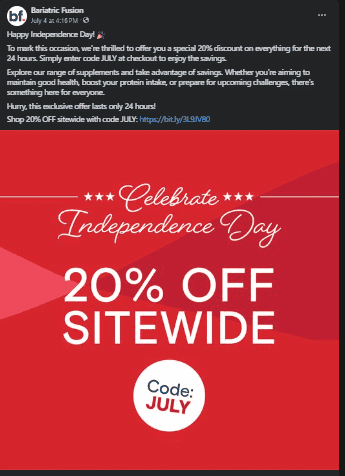
Source: Facebook
Their Independence Day post, set against a vibrant red background, celebrates the holiday by offering an exclusive 20% discount on all products for 24 hours. The discount code “JULY,” presented in a red-white-and-blue color scheme, strengthens the connection to the occasion, making the offer more enticing and easier for the brand to track its success.

Source: Facebook
The World Chocolate Day post includes a link to a recipe for Chocolate Chia Pudding, a healthy and delicious treat that aligns with the brand’s focus on health and wellness. This clever promotion of chocolate-flavored protein powder inspires potential customers to try it while bringing value to the audience.
Key takeaways
Develop a content calendar.
Plan your social media posts and align them with relevant holidays, events, and industry trends. This will help you maintain a consistent posting schedule and create content that resonates with your audience.
Aim for a posting frequency that aligns with best practices for each platform:
- 3-5 times per week for Instagram and TikTok
- 1-2 times per day for Facebook and LinkedIn
- 2-3 times per day for Twitter and Threads
- at least once per week for Pinterest and schedule posts on Google My Business with a similar cadence
Focus on value.
Every post should add value to your followers. This could be a discount or promotion, a helpful tip or tutorial, an inspirational story, or simply a beautiful image that reflects your brand aesthetic.
Promote subtly.
Integrate your products or services into your posts in a natural and organic way. Avoid using overly salesy language and focus on showcasing how your products can improve your customers’ lives.
Keep in mind that these are just general guidelines.
For example, the ideal posting frequency for your ecommerce business will depend on various factors, including audience characteristics, engagement levels, content type, and partnership with an experienced Ecommerce SEO Agency. Experiment to find what works best for your store, and don’t be afraid to tweak your strategy accordingly.
2. Great Lifestyle Content Generates the Right Emotions
What emotions does Nike’s “Just Do It” campaign evoke?
Enthusiasm?
Endurance?
The thrill of victory?
These powerful feelings are the same ones that ecommerce brands leverage across social media, transforming products into symbols of lifestyle and aspiration.
Chisos, a cowboy boots company based in Texas, reflects the spirit of the Lone Star State on its Instagram feed. The brand celebrates Texan pride, showcasing its handcrafted boots in rugged landscapes and bustling city streets. Chisos’s social media strategy is not focused solely on the boots — it tells the story of the resilience, independence, and love for Texas that those boots symbolize.
“Life is all about the climb. It’s not about the view from the top. It’s about the work you put in that got you there. The view wouldn’t be as sweet if there wasn’t any struggle.”
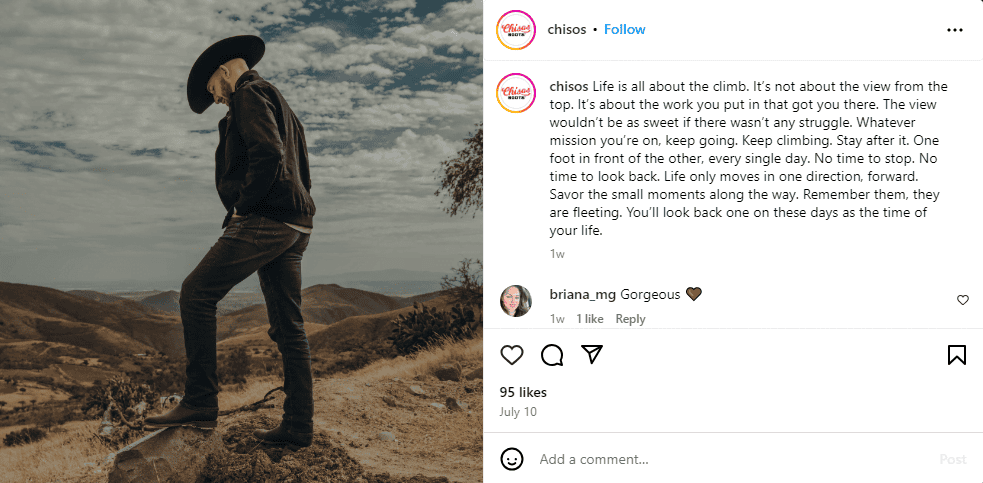
Source: Instagram
Accompanied by an image of a cowboy traversing rocky terrain in Chisos boots, the post is all about the Texan spirit of perseverance and hard work. It subtly suggests that Chisos boots are stylish but durable and that they won’t let you down along the way.
Key takeaways
Define your brand lifestyle.
What values, experiences, or emotions does your brand represent? Chisos clearly represents Texan pride, resilience, and a love for the outdoors. Once you’ve identified your brand lifestyle, let it guide your content creation.
Show, don’t tell.
Instead of simply stating what your product does, showcase it in action. Create visually appealing content that demonstrates how your products fit right into your target audience’s lifestyle, like Chisos, by featuring their boots in various Texan settings.
Tell a story.
Craft narratives around your products. Share customer testimonials, behind-the-scenes, or UGC that highlights real-life experiences with your brand.
Evoke emotions.
Use high-quality visuals, captivating captions, and authentic storytelling to stir emotions that resonate with your audience. The right emotions — joy, excitement, relaxation, or inspiration — can drive engagement and conversions.
3. Instructional Content Breaks Down Conversion Barriers
Shopping for products with unique features or that address specific needs or require assembly can sometimes feel like a leap of faith.
If buyers are unsure about how a product works, its size and fit, or its compatibility with their lifestyle, they’ll hesitate to make a purchase. Clear, tailored instructions empower customers to understand your product’s features and make informed decisions.
Wholewood Playhouses, a company selling DIY playhouse kits, cleverly uses their YouTube channel to show how simple it is to construct their prefab playhouses. Their short, easy-to-follow Kids Playhouse Assembly video breaks down the building process and eliminates this common barrier to purchase.
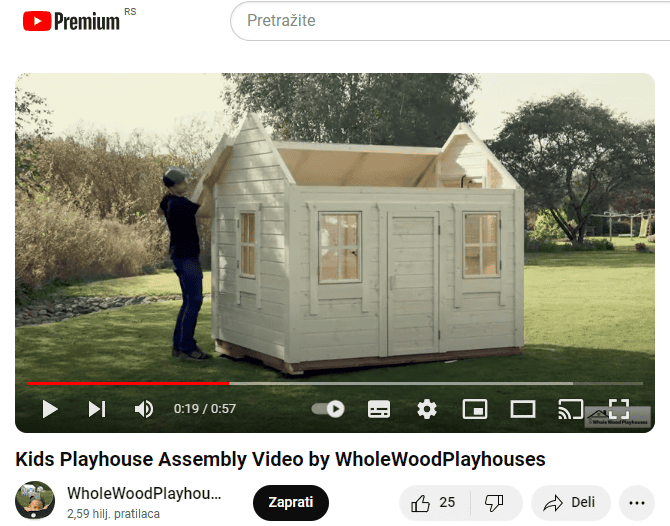
Source: YouTube
Instructional content doesn’t stop at assembly videos.
Think about showcasing the practical applications of your product. If you sell clothing, create styling videos or lookbooks. If you sell tech gadgets, share tutorials on how to maximize their features. Even simple FAQs or size charts can help relieve customers’ doubts and encourage them to click “Add to cart.”
Key takeaways
Identify your audience’s pain points.
What questions or concerns do your customers usually have about your products? Do they struggle with assembly? Do they need clarification on sizing or compatibility? Specifying these pain points will guide your content creation.
Diversify your content.
Don’t limit yourself to one format. Experiment with how-to videos, blog posts, infographics, live Q&A sessions, or interactive quizzes. Aim to make information easily accessible and engaging.
Make it shareable.
Instructional content often has a long shelf life and can attract organic traffic. To reach a wider audience, optimize it for search engines and encourage sharing.
Track and iterate.
Monitor how your instructional content performs. Do your customers engage with it? Are they satisfied with the answers you provide? Use this feedback to improve and expand your library of resources continuously.
4. UGC on Social Media Elevates Brand Credibility
Captivating ads and stunning product images might catch your shoppers’ eyes, but it’s the authentic experiences of fellow customers that they genuinely want to know more about.
User-generated content (UGC) is word-of-mouth amplified. It builds trust and credibility by offering social proof that speaks louder than any carefully crafted marketing message.
Pergola Kits USA, a company specializing in DIY pergola kits, uses customers’ real-life stories and photos to showcase the beauty and functionality of their kits on their Facebook page.
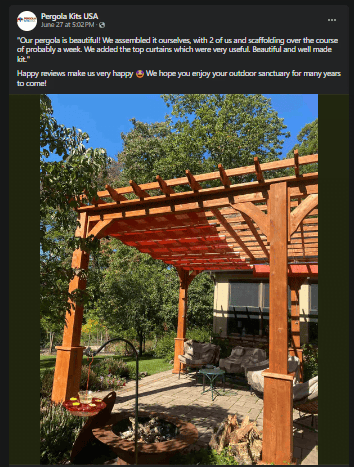
Source: Facebook
By sharing these authentic experiences, Pergola Kits celebrates their customers’ creativity and DIY spirit. At the same time, they give tangible proof of the quality and value of their products. Seeing real people enjoying real pergolas creates a sense of connection and trust that no advertisement can match.
Key takeaways
Actively encourage UGC.
Entice your customers and make it easy for them to create and share their stories. Create branded hashtags, run incentivized contests, or simply ask for reviews and photos.
Curate and showcase.
Not all UGC is created equal. Select the most compelling, high-quality content that aligns with your brand image and values. Showcase this content prominently on your social media channels, website, and even your email marketing campaigns.
Engage and appreciate.
When customers share their experiences, acknowledge their contributions. Thank them for their support, answer their questions, and share their posts. Your positive feedback fosters a sense of community and encourages further engagement.
Leverage different platforms.
UGC isn’t limited to Facebook. Encourage customers to share their photos and videos on Instagram or even create unboxing videos on YouTube — the more diverse your UGC, the wider your reach and impact.
5. Embrace Newer Platforms Like TikTok to Diversify Your Audience
While Facebook and Instagram are stalwarts in ecommerce, newer platforms like TikTok allow you to maximize tikTok engagement and tap into new demographics and expand your reach.
With its short-form, highly engaging video format, TikTok is a natural fit for ecommerce businesses that want to showcase their products creatively.
In fact, in 2023, an estimated 37% of TikTok users in the US — a staggering 55.5 million — made purchases either through links on the app or directly on the platform. This trend is only expected to accelerate. Projections indicate a 67% increase in US TikTok social shoppers by 2026, potentially reaching 39.5 million.
Gain The Edge Official, a company selling performance clothing, successfully uses TikTok to demonstrate the benefits of grip socks. Their videos feature athletes from various sports, revealing how the socks improve their performance through enhanced grip and stability.
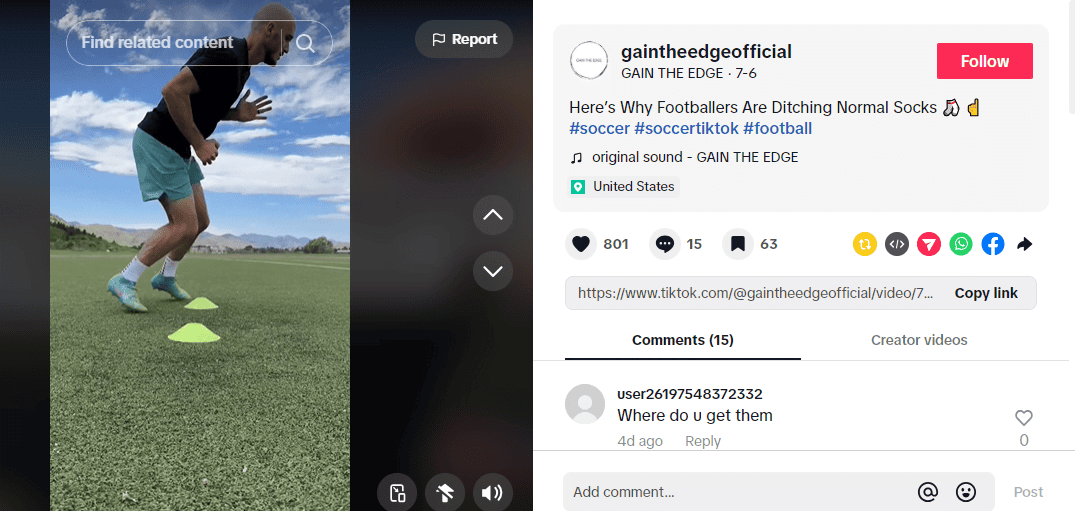
Source: TikTok
The company also uses TikTok to educate their audience about the technology behind the product. They explain how the unique design improves footwork and reduces the risk of slipping.
This combination of entertaining and informative content resonates with many sports enthusiasts, helping the brand gain traction on the platform.
Key takeaways
Understand the platform.
Before diving into TikTok, familiarize yourself with its culture, trends, and algorithm. This will help you create content that addresses the platform’s mostly younger audience.
Think visually.
TikTok is a visual platform, so make sure your content is attention-grabbing and dynamic. Use high-quality footage, creative editing, and trending sounds to capture attention.
Keep it short.
TikTok videos are typically 15 to 60 seconds long. Get to the point quickly and leave your audience wanting more.
Embrace trends.
Participate in trending challenges or create branded challenges to boost engagement and visibility.
Collaborate.
Partner with influencers or other brands to cross-promote your products and reach new audiences.
6. Social Media Interactions Show Your Brand’s Commitment to Service
What’s the secret to turning curious shoppers into loyal customers? Often, a fast and helpful response on social media can do the trick.
Your interactions online directly reflect your commitment to customer service, and that commitment can make all the difference in building a thriving ecommerce brand.
Infraredi, which specializes in infrared saunas, excels at customer engagement on their Facebook page. When a customer wants to know more about their product, Infraredi doesn’t just give a generic answer. They offer a helpful explanation.
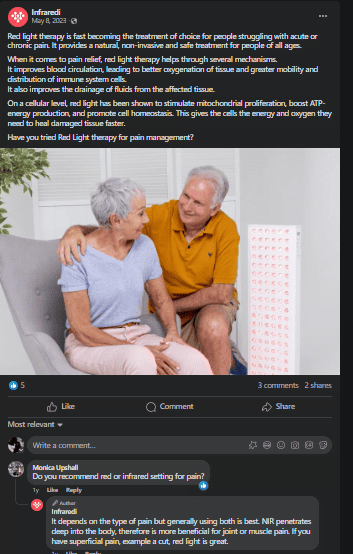
Source: Facebook
This kind of response shows their knowledge and expertise in solving the customer’s problem. It builds trust and confidence in the brand. It shows that Infraredi is invested in their customers’ satisfaction even after the sale, which is a quality customers highly appreciate.
Key takeaways
Be responsive.
Don’t leave your customers hanging. Respond to inquiries and comments within a reasonable timeframe, ideally within 24 hours. If you can’t solve their problem, acknowledge their message and tell them you’re working on it.
Be helpful.
Go beyond generic responses. Offer personalized solutions, relevant resources, or direct contact information for further assistance.
Be proactive.
Don’t just wait for customers to reach out. Monitor your social media channels, use social listening tools for mentions of your brand or industry, and proactively engage in conversations.
Be human.
Use a friendly and approachable tone in your interactions. Show empathy and understanding, even if the customer is frustrated or upset.
Turn negatives into positives.
If a customer expresses dissatisfaction, it is an opportunity to turn things around. Address their concerns and try to find a solution that leaves them feeling heard and valued.
Final Thoughts on Ecommerce Social Media Marketing Strategies
Social media is a powerful tool for connecting with customers, driving sales, and building a community around your ecommerce brand. By incorporating the six essential principles we outlined in this article, you can reap all the benefits of platforms like Instagram, TikTok, Facebook, and YouTube.
Remember, social media success doesn’t happen overnight. It requires consistent work, a flexible mindset, and a willingness to learn and adjust. By actively engaging with your audience and tracking your results, you can ensure your social media efforts continue to benefit your business.

